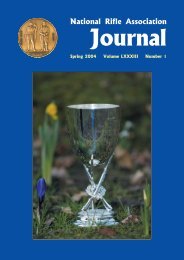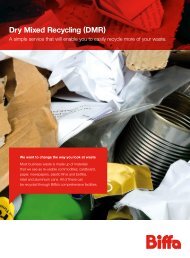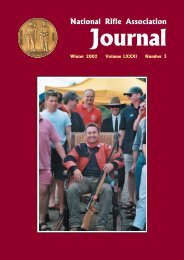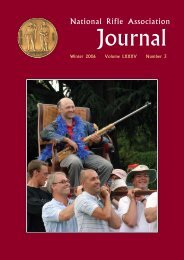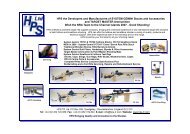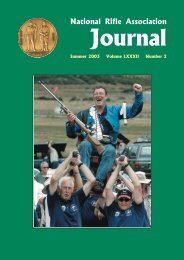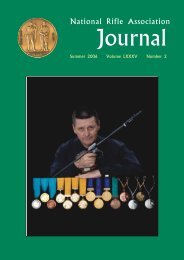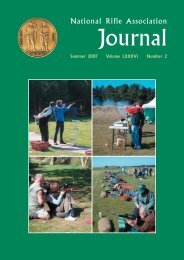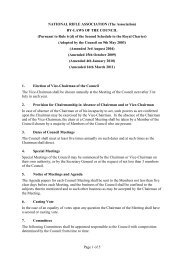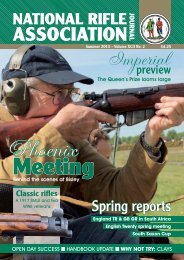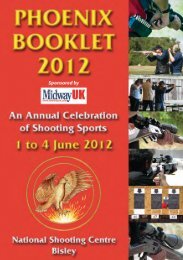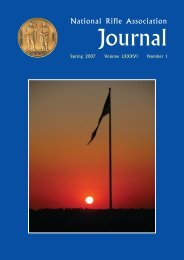NRA Journal - Spring 2011 - National Rifle Association
NRA Journal - Spring 2011 - National Rifle Association
NRA Journal - Spring 2011 - National Rifle Association
Create successful ePaper yourself
Turn your PDF publications into a flip-book with our unique Google optimized e-Paper software.
The Australia Match 2010by Nigel Ball and Martin TownsendThe year 2010 was the 150th anniversary of thefounding of the <strong>National</strong> <strong>Rifle</strong> <strong>Association</strong> of GreatBritain and several events were planned to celebratethis auspicious occasion. Foremost amongst themwas the hosting of the highly prestigious Australia(formerly Empire) Match. This match is consideredby shooters to be second in ranking only to the Palmaand is one of the Big 5 that GB shooters aspire to, theothers being the Palma Trophy, the Kolapore, theMackinnon and the <strong>National</strong> Match. A person whohas represented his country in all five of these matchesis then entitled to wear the Big 5 tie and badge – therehave been only 92 people since 1860 eligible to bearthis honour.Nominations for captaincy of the team were called forin early 2009. Someone who was currently involvedin GB teams and who had the strategy for winningwas needed as the Australians were the currentholders of the match, having won it in Brisbane in2005. The successful candidate was Martin Townsend,many times Captain of Ireland and leader of thephenomenally successful 2006 team to Canada andthe 2007 Palma Captain; he did not entertain any ideasof losing such a match. He was duly appointed andselected Nigel Ball, his faithful Adjutant from 2006 and2007 to be at his side. So the work began.The match was originally scheduled for the Mondayfollowing the 2010 Imperial Meeting. It soon becameapparent that several of the visiting overseas teamswould be unable to extend their stay for those extratwo days; months of negotiations eventually changedthe day to the Sunday after Queens Final – at leastthere would be spectators that day! It was also decidedthat everyone would use an issued batch of theextremely good RUAG ammunition rather than theirown loads meaning that visiting teams did not have toworry about the expense of transporting ammunitionto Great Britain.Major General John Hartley and John Fitzgerald of the <strong>NRA</strong> ofAustralia kept a careful eye on the proceedings.The match was to be shot on the ICFRA target,tighter in dimensions than the <strong>NRA</strong> target and withsmaller aiming marks – only the best GB shooterswho were on form would make the team. Selectionwas left as late as possible to allow performance overthe 2010 Imperial Meeting to be taken into accountand although a training squad had been formalised,anyone who performed well was also considered.A main coach was chosen reasonably early to assistwith selection and monitoring of performance; itwas decided to give the job to Bill Richards, veteranof many fine GB winning teams and as dedicated towinning as the Captain and Adjutant. The hierarchymet frequently before and during the 2010 Imperialbut final selection was eventually decided on SecondFriday, the day before the Queen’s Final, and theteam announced. Several new caps had made it, GazMorris of Welsh Commonwealth Games fame andChris Watson of Surrey clubhouse Doom Bar fame.One day to go and all looked fine until one of theselected ten, David Calvert, won HM the Queen’sPrize. Would he elect to celebrate his longed forSovereigns Prize or desist for Australia Match glory?He chose the former and who could blame him! Thereserve, Tom Rylands, was therefore shooting and anew reserve, James Watson, nominated.So to Sunday and match day. There were six teamsin all: Great Britain, Australia, Canada, the ChannelIslands and Germany with the final team being a mixof Malaysia, Holland and Japan, henceforth known asMaHoJa. It was dry but cool and overcast at times withthe odd patch of sun, a typical British summer day.The Australians under the captaincy of Rick Scoonesopened up in great style with only three points off,winning 300 yards by a point from GB with ChannelIslands a further three points behind. There were 23possibles at 300 yards from 60 shooters and with a50.10 from Dan Richardson of Channel Islands whichis no mean achievement on an ICFRA target.Were GB fazed? Not at all – the target at 600 yards wassignificantly tighter and confidence in the coachinggroup, Bill Richards, Jeremy Langley and Jane Messerwas at a high. And so it proved: under particularlyvariable conditions GB dropped only six points at600 yards with the Channel Islands dropping nine.Australia had a very trying time losing 17 points atthis range, three more than Canada and falling to thirdplace overall.Lunch called with short range finished and the currentpositions being, GB – 10 off, CI – 16 off, Australia – 20off, Canada – 25 off, Germany – 38 off and MaHoJa –49 off. Predictions about 600 yards being a true test ofmarksmanship were proven when only nine of the 23possibles from 300 yards went on to record a second31



